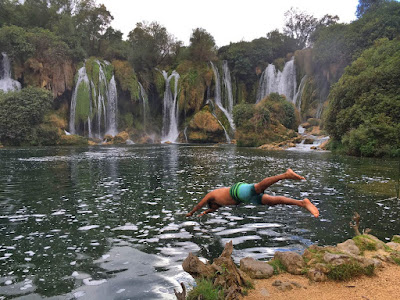Sept 17 - 19
A last minute change of plans led us to Bosnia. And boy am I glad it did!
Mostar was badly hit by the Yugoslavian civil war. The damage, more than twenty years later, is still evident on many of the streets and buildings.
Stari Most (the 'Old Bridge') was completely destroyed by the Croatians and was rebuilt exactly how it was originally built - despite the progress of technology, UNESCO insisted that it be built using not only the same design and materials, but also the same building techniques.
So the famous "Old Bridge" is really not that old at all. However, it is still a beautiful and unique bridge.
Standing 24m tall, it enthuses many dare devils. But before jumping, one must be trained by a local - jumping off a rock just down the river, practising exactly how to land in the water to minimise the risk of injury. Or death. Apparently there is an average of one serious injury per day..! So, no. I most definitely did not jump. I did watch a few people jump though!
 |
| Pretending like he's gonna jump... |
 |
| Actually jumping! |
After roaming around the Old Town (again, not really "old" these days) we headed to the sniper tower. The Croatians used this tower as a base to attack Mostar. Bullet holes were cleverly used in some of the art that covered the walls. We checked out the extensive street art and graffiti on the outside before we jumped over the walls to get inside.
Once in, we found more graffiti, plus tons of rubbish and broken glass - from all the windows that no longer exist. Climbing up the floors, we got changing views. At one point while we were admiring the view, I found "If happy, look. If sad, jump" spray painted on the ledge.
The views were incredible but it was surreal, standing in a sniper tower that was used in a horrendous war only 20-odd years ago.
We finished off our afternoon at the Stari Most museum, which to be honest was a bit of a waste of time and money. There was lots of dull information about the original constuction of the bridge, very little about how the bridge was destroyed and a decent video about the reconstruction. To be fair, there was a pretty good view from the tower at the top.
The next day we signed up for a full-day tour run by the hostel, which came highly recommended by many people.
Zika firstly took us up to Hum Mountain, which looks over Mostar. He was only 16 when the war began and at 17 he joined the resistance. While at the peak, he told us his own personal war stories; of being shot, of burying his classmates. All this while we stood at the spot where Croatians shot and killed many Bosnians, both soldiers and civilians.
Our next stop was a tunnel used as an air base during the war. We walked through the darkness and explored the man made rooms inside, big enough to sleep 100 soldiers. In the middle of the tunnel, we turned off all our lights and torches and screamed out, listening to a never ending (rather spooky) echo.
Moving on from our rather dark war-related stops, we went to the Dervish house in Blagaj. A beautiful little house built right next to a cave, between a fast flowing river and a massive rock formation.
Unfortunately the weather turned a little miserable as we approached our next stop, Kravica waterfalls. The one place we really wanted it to be sunny, so that we could go for a swim! There was no way I was getting in the icy cold water on an already cold day. Aamer braved it (very quickly) for a photo op.
The last stop was the historical town of Pocitelj. We walked up to the castle and then to the fortess, admiring pretty wicked views of the mountains and the river at both.

















No comments:
Post a Comment